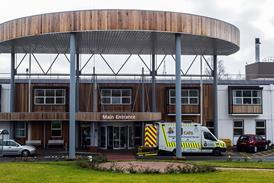The NHS sees virtual wards as a solution to many problems. But making a success of them depends on more than the availability of beds. An HSJ webinar, supported by The Access Group, brought together four experts to discuss the issues.
In association with
When talking about how to make virtual wards better, it helps to be working with a common definition of the concept. Rezina Hakim, author of Realising the potential of virtual wards for the NHS Confederation, described the model as an evidence-based and IT-delivered system of care “where systems come together to provide offline care”, crucially, within a patient’s home.
The decision to place a patient in a virtual ward, she added, is one taken by a multidisciplinary team, including relevant acute, community, and mental health professionals.
Virtual wards took off during the pandemic as a way of keeping people out of hospital. This had obvious benefits for social distancing as well as hospital bed capacity. But now trusts are being asked to roll them out at greater speed and are managing to hit targets of around 40–50 beds per 100,000 of population.
The challenge, Ms Hakim suggested, is supplying the resources if virtual beds are to deliver the same standard of care as hospital beds.
“We know that to fulfil that potential, we really need to ensure that we have the right mix of staff and that investment in staffing. And the workforce really needs to be long term,” she said.
She added that a critical success factor is the flow of data between the various points of care, including after discharge from a virtual ward. Understanding patients’ needs across this spectrum will help reduce readmission into virtual wards and presentation in emergency departments.
One man with first-hand experience of those data flows is Umesh Gadhvi, chief data and information officer at North East London Foundation Trust. He shared how important “process mapping” was in rolling out a virtual ward for acute respiratory care, especially given the number of systems, stakeholders, and integrations involved. He also explained in detail the steps the trust took to make it a success.
A key lesson learned was not to “start off with the tech solution”. Instead, “always start off with the process mapping solution, understanding the needs and wants of the service [and] the patients and then make sure the data flows”.
Mr Gadhvi also underlined the importance of including patients when building pathways.
“We got those patients to take the tablets home,” he said. “These were patients already in the community respiratory pathway, and we were able to then get the solution to work even better with their input.”
The importance of the patient experience is not lost on Chris Sherlaw-Johnson, senior fellow at the Nuffield Trust.
“Operational measures [like bed numbers] are useful for understanding capacity and planning activity,” he said. “But there are many things they don’t tell you about.” These include quality of care, safety, patient outcomes, and what the patients think.
Mr Sherlaw-Johnson favours developing metrics that are going to be useful across a service. These might include reasons for admission, patient characteristics to measure inequalities in outcomes, and what other support a patient is receiving.
This data serves two purposes, he argued: continuously monitoring the service for safety and operational purposes, but also evaluating whether wards are meeting their targets in reducing admissions elsewhere, for example.
A recurring challenge in the discussion was the complexity of integrating various systems. This is something that Chris Wilson, product director, integrated care at The Access Group sees both within providers and on a regional and national level.
“I think we’re at the beginning, from a data perspective,” he said, noting how providers have had to stand up virtual wards quickly and focus on building data feeds that can quickly lead to siloes. These inevitably make it harder to run and scale wards efficiently.
“So, we don’t want to be running virtual wards and having people having to go looking for data and information the whole time. It’s not a good use of clinical time trying to find out someone’s latest observation data, or which GP this person is allocated to.”
Mr Wilson said that digital services should “allow our virtual wards to be really efficient, particularly when we’re trying to treat patients that we can’t see face to face”.
Audience members were keen to understand the finances behind virtual wards and how they might establish a business case.
Doing this, according to Mr Sherlaw-Johnson, depends on robust before-and-after data showing the difference that a virtual ward makes: “You’ve got the groups of patients within the area that would be eligible for the virtual ward but aren’t being admitted. You could do that tracking quite easily. And you could also look at things like admissions to care homes, if necessary, as well.”
Mr Gadhvi explained that his team is monitoring a range of metrics for patients, as well as for staffing and costs.
“Over the next six months we will see what that looks like from a financial perspective,” he said. “[We can] then build out the entire business case, with all those benefits, to look to fund the expansion.”
Ms Hakim noted that longer-term thinking about virtual ward performance would assist with funding, but recognised restrictions around funding cycles for underlying infrastructure.
“Some of these large-scale data programmes that are fundamentally underpinning virtual wards and various other programmes [are] long term. And if we are to have short-term funding cycles, it’s not possible to realise those benefits.”
Of course, all this data collection relies on critical integrations between systems, which Mr Wilson confesses can be challenging. “It’s about being bullish with system providers,” he said. “It definitely can be done. It’s not easy. But I think the results are quite significant.”
An on-demand version of this webinar is available.
To access the recording, visit here and click play.
If you have previously registered for the event, clicking the link will immediately bring you to the recording. Simply press play.
If you have not previously registered, complete the form that appears. You’ll then be able to immediately watch the recording.


























